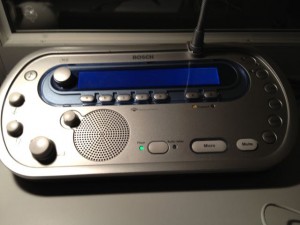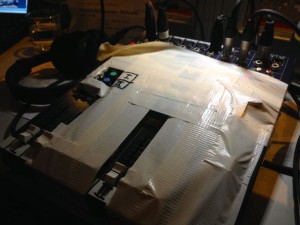Flexibilität is the interpreter’s middle name.
A good interpreter is not only silver-tongued, quick on the uptake and stress-resistant, no – he or she has to be endowed with a full measure of flexibility. An agenda that changes at short notice, a friendly gentleman takes the floor and, surprise surprise, speaks not about the brown bear (the research field of the initially invited speaker and a topic the interpreter prepared for in days), but about his own specialty, the Male Blue Ringtail (a damselfly or dragonfly). A CEO spontaneously asks the simultaneous interpreters to leave the booth and switch to consecutive interpreting – anything might happen.
In certain cases the interpreters’ flexibility is strained in other fields as well.
To make the reader understand what this is about I include the image of a classical interpreter console. An interpreter’s console looks like that. A detailed description can be found here, with an explanation of all the specific features covered by this interpreter console. The essential element is the gigantic button labelled “Micro” highlighted in red once the microphone is switched on. That provides the interpreter with the important information that his or her translation comes through to the recipients in the conference room.

Some time ago the team of interpreters stepped into the interpreting booth in a conference centre and was faced with the hulking device displayed below.

Initially we assumed that this contraption just had been forgotten in the fixed interpreting booth. We called for the house technician, a friendly guy who promptly informed us:
“N0 no, everything is in perfect order, this is our interpreter’s switchboard”.
I was stunned. The technician looked at my face and and pointed out that this was, after all, just a small mixing console, with a limited number of control elements (just a cool 44 knobs and at least 8 slide controls!) It should be quite easy to use, he said… I do not tend to panic, however the mere thought of translating extremely complicated technical presentations on mechanical engineering while trying to locate the volume control in this forest of knobs somewhat darkened the mood.
Mind you, there is a solution for every problem. Since good interpreters make a point of being very punctual (and punctuality in our profession means to arrive (at the latest) 30 minutes before the conference starts) there was enough time to talk the obliging technician into redesigning the console in a quite creative way. Have a look at the result! ,

Our “interpreting console” now looked like an object wrapped by Christo or like a Kafkaesque creature…the only controls visible and usable were the two white microphone slide controls and the respective volume controls.
The alteration work was completed just 10 seconds before the conference began. Nerves of steel were called for.
To our great amazement the construction served us quite well – although we could work only from German into English; technically we couldn’t have translated from English into German…
That was a droll episode, but if a dialogue is required the original, meaning a real interpreter’s console.

